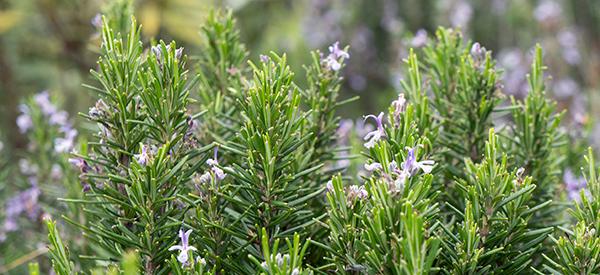
Rosemary
Rosemary (Salvia rosmarinus), formerly known as Rosmarinus officinalis, was originally named in the 1700s. In 2017, rosemary joined the genus Salvia. The Mediterranean woody shrub commonly known as rosemary has many culinary and medicinal qualities. The Latin, ros-marinus, translates to dew of the sea.
Currently, many investigations into the medicinal properties of rosemary are being undertaken. For good reason, the pungent herb has been associated with many healthful attributes including improved memory. In fact, in the language of flowers, popular during the Victorian age of the 1800s, rosemary symbolizes remembrance.
There are many theories that suggest different ways of improving memory or thinking more clearly. One of those is the idea that adding rosemary to your food or water or even breathing in its scent, can give your brain a boost. Add a few drops of rosemary oil to lotion and apply it to your neck, or use a diffuser to reap the mental benefits of rosemary oil’s aroma. Whenever you need a boost of mental energy, you can even inhale over a bottle of oil to get the same effects.
A useful landscape and garden plant, rosemary is a vigorous perennial shrub in ideal conditions of full sun, excellent draining soils, in zones 7 and above. In colder climates, rosemary is a welcome indoor plant in winter.
Vast culinary uses of rosemary are well known around the world. The fresh or dried leaves have many applications including providing flavor to meats, fish, vegetables, breads, stuffing, herbal butters, oils, vinegars, and other condiments.
The History of Rosemary
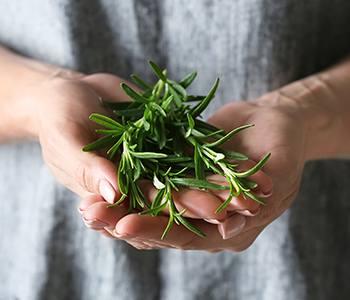
With over 7000 years of documented usage, rosemary has been used by humans extensively throughout our history. Rosemary is noted in stone tablets dating back to 5000 BCE, and its use assumably continued throughout the early civilizations with documentation of its use in ancient Egypt, Greece, and Rome. Rosemary had naturalized through areas of China by 220 CE.
With other medicinal herbs, rosemary was promoted and grown throughout many parts of Europe during the campaigns of Charlemagne during the 8th century CE. Its popularity grew and had naturalized in many areas by the beginning of the 1400s.
During the 17th century, rosemary made its way around the globe, first with early European settlers arriving in America, spreading throughout North and South America and throughout the world.
Where the Plant is Found
Rosemary is hardy in zones 7 and above. It thrives in zones 8 to 10. It is native to the dry, seaside Mediterranean region but has naturalized throughout warm areas of Europe, Asia, and beyond. It thrives in full sun in medium soils that are slightly acidic.
A popular landscape plant, rosemary may be found commonly in landscaped areas and gardens in addition to its wild dry, scrub native ranges.
Related: The Complete Map of Edible Plants: Find Out What You Have in Your Area! (Video)
How to Identify Rosemary
- Shape: Upright, rounded, evergreen shrub grows 4 to 6 feet tall.
- Leaves: The needle-like leaves are up to 1.5 inches long, gray-green in color, with pale undersides.
- Flower: Two-lipped blue to white flowers are tiny. They bloom in early spring in clusters at the axils of last year’s wood.
- Stem: Smooth, square stems.
Related: Plant Identification Guide – 400 Wild Plants That You Can Forage For (Video)
How to Grow
Rosemary is a vigorous shrub in its preferred growing conditions. These are warm, full sun, extremely well-draining soils that are slightly acidic. Mimic the natural environment to its native growing conditions whenever possible. This is one way to have success growing rosemary.
For companion planting, rosemary’s friends in the garden include sage, carrots, cabbage, and beans.
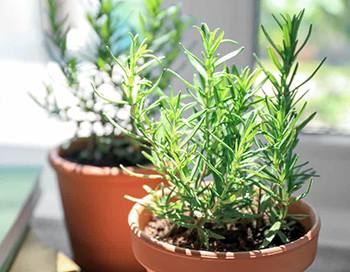 Enemies of rosemary are poor air circulation, high humidity, and heavy, damp, clay soils. These conditions may lead to diseases such as powdery mildew, botrytis, and root rot. Insect pests may become problematic for unhealthy plants as well. These include aphids, whiteflies, mealybugs, and spider mites, particularly problematic for indoor growing.
Enemies of rosemary are poor air circulation, high humidity, and heavy, damp, clay soils. These conditions may lead to diseases such as powdery mildew, botrytis, and root rot. Insect pests may become problematic for unhealthy plants as well. These include aphids, whiteflies, mealybugs, and spider mites, particularly problematic for indoor growing.
That being said, it is worth growing rosemary in pots that can be brought inside during the winter months. Allow excellent drainage, at least 6 hours of sunlight per day, and water minimally for success.
Plants can be started from seed or cuttings. Seed germination takes 2 to 3 weeks so be patient.
Related: 10 Plants That You Should Never Plant Together (Video)
How to Harvest This Plant
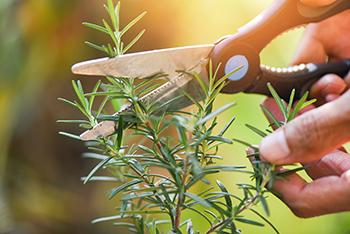 Like many other plants in the mint family, pinching branch tips results in multiple branches. So pinching plants can help shape rosemary plants and encourage them to branch out nicely. Since it blooms in early spring on last year’s wood, you want to prune it or harvest it soon after it blooms. This is because cutting off all this year’s growth in fall will not leave wood for next year’s spring blooms. Blooms can also be harvested for culinary and medicinal purposes.
Like many other plants in the mint family, pinching branch tips results in multiple branches. So pinching plants can help shape rosemary plants and encourage them to branch out nicely. Since it blooms in early spring on last year’s wood, you want to prune it or harvest it soon after it blooms. This is because cutting off all this year’s growth in fall will not leave wood for next year’s spring blooms. Blooms can also be harvested for culinary and medicinal purposes.
For full-sized mature rosemary plants, shaping and pruning are good to keep the plant tidy. Harvesting can be done anytime throughout the year on large mature shrubs as well.
For the best flavor, harvesting in the afternoon from slightly dry plants may result in leaves with the strongest flavor.
What Rosemary Is Good For and The Natural Remedies Made From It
The rosemary plant produces many beneficial substances. Some of these benefits are antispasmodic, anti-depressant, antimicrobial, carminative, aromatic, astringent, and stimulatory actions.
Fresh or Dried Culinary Rosemary – Food As Medicine
Rosemary is a delicious, earthy, pungent herb that is excellent for flavoring many foods. It is a favorite in seasoning poultry and cannot be absent when making stuffing or gravy. Other meat and fish benefit from strong flavors. Grains, pilafs, legumes, vegetables, egg dishes as well as stews and soups are enlivened with the aromatic powerful flavor. For culinary use, it is recommended to use rosemary sparingly due to its strong flavor which can be overpowering in some dishes.
Rosemary Tea
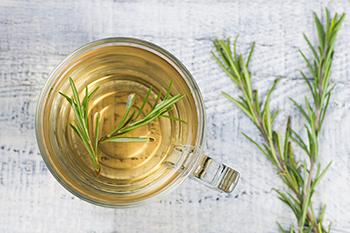
Rosemary tea is enjoyable and exceptionally good for you. A potential benefit is in helping to reduce high blood sugar by aiding the absorption of glucose. Rosemary tea hosts a powerful antioxidant, anti-inflammatory, and antimicrobial combination. Rosemary is a useful therapy for many gastrointestinal discomforts such as indigestion and bloating. There is evidence that rosemary tea may protect vision as we age. Importantly, drinking rosemary tea has shown many benefits for brain health including protecting brain cells, and may even help to repair brain damage due to injury and aging.
Related: Add This “Unusual Nutrient” to Coffee or Tea, to Effortlessly and Fully Empty Your Bowels Every Single Morning (Learn More)
Rosemary Essential Oils
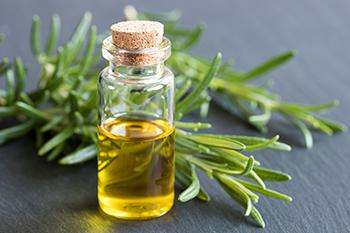 Rosemary is also often used in aromatherapy, making an exquisite essential oil that is perpetually useful around the home. Studies are showing promise that inhaling rosemary essential oil is helpful to improve memory and mental focus, relieve pain and inflammation, improving mood, and easing stress. Topically, there is evidence that rosemary essential oil helps to fight hair loss, also known as alopecia. Due to its antimicrobial properties, rosemary is wonderful in the diffuser to aid in cleaning the air. It is also an excellent essential oil to use in homemade cleaning solutions and homemade thieves oil.
Rosemary is also often used in aromatherapy, making an exquisite essential oil that is perpetually useful around the home. Studies are showing promise that inhaling rosemary essential oil is helpful to improve memory and mental focus, relieve pain and inflammation, improving mood, and easing stress. Topically, there is evidence that rosemary essential oil helps to fight hair loss, also known as alopecia. Due to its antimicrobial properties, rosemary is wonderful in the diffuser to aid in cleaning the air. It is also an excellent essential oil to use in homemade cleaning solutions and homemade thieves oil.
Related: Homemade Anxiety and Stress Tincture (Learn More)
Rosemary Extract
An extract of rosemary leaf has shown potential to help treat and prevent dementia as well as provide improvement toward cognitive function in older individuals. Impressively, rosemary extract used topically showed evidence to help block certain skin tumor cells and inhibit the growth of some other cancer cells.
What Parts of Rosemary Are Used in Remedies?
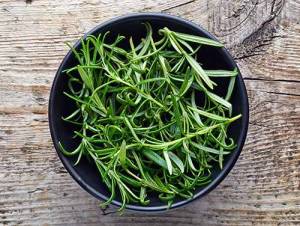 The leaves are the primary plant part used in remedies. The stems are also highly aromatic. Flowers of rosemary, although tiny, do carry many of the beneficial properties found in the leaves.
The leaves are the primary plant part used in remedies. The stems are also highly aromatic. Flowers of rosemary, although tiny, do carry many of the beneficial properties found in the leaves.
Rosemary is available as dried whole leaves, tea, tea blends, in powdered form, and in capsules. Products made with rosemary are also available such as tinctures, and liquid extracts. Rosemary essential oils are available through many essential oil companies. These are highly concentrated volatile oils from the distillation of rosemary plants.
Two DIY Recipes – Rosemary Scalp and Hair Spray & Rosemary Hair and Scalp Massage Oil
Further to ongoing research, rosemary oils and extracts have shown promise in reducing hair loss and promoting thicker, healthier hair. In fact, some studies show diluted rosemary essential oil goes toe to toe against Rogaine, to similar effect!
I began losing hair to the point of having small bald patches at my hairline. Among other lifestyle changes, I also started making this hair spray and scalp oil and using it on a regular basis. For the past couple of years, it has helped tremendously. Not only are the bald patches much reduced, but also areas of widening where I part my hair are much less noticeable. My hair is markedly thicker as well.
Method
Ingredients:
- Fresh or dried rosemary.
- Fresh or dried lavender flowers.
- Fresh or dried chamomile.
Hair Spray:
- 1 teaspoon each, dried rosemary, lavender flowers, and chamomile flowers, or 1 tablespoon each fresh rosemary, lavender flowers, and chamomile flowers.
- 1 ounce Apple Cider Vinegar
- 1 ounce High-Quality Water
Hair Oil
- 1 teaspoon each, dried rosemary, lavender flowers, and chamomile flowers, or 1 tablespoon each fresh rosemary, lavender flowers, and chamomile flowers.
- 1 ounce Castor Oil
- 1/8 ounce Avocado Oil
Step 1: Find rosemary growing in the herb garden, at the farmer’s market, at the greengrocer, or the spice aisle. In the photo, don’t mind the mess of the late summer herb garden and a young rosemary plant growing with dill, amaranth, and mint.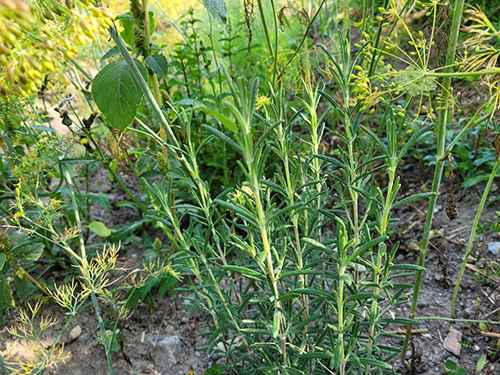
Step 2: Snip off some branch tips and give a gentle wash.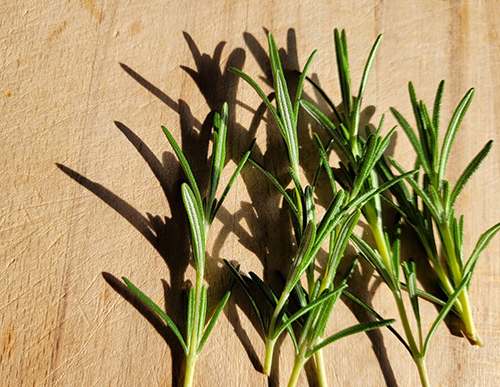
Step 3: Gather remaining ingredients.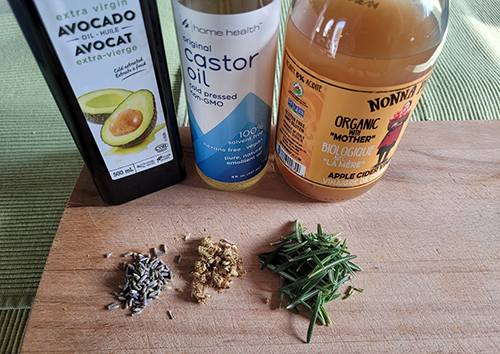
Step 4: Place rosemary, lavender, and chamomile in small glass containers. These are upcycled spice jars.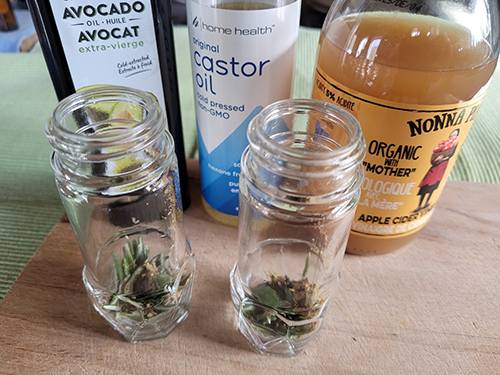
Step 5: Add oils to one jar and vinegar and water to the other. Allow the mixtures to steep for up to 1 week for fresh or mixed ingredients. Allow the mixtures to steep for 4 to 6 weeks if using dried ingredients.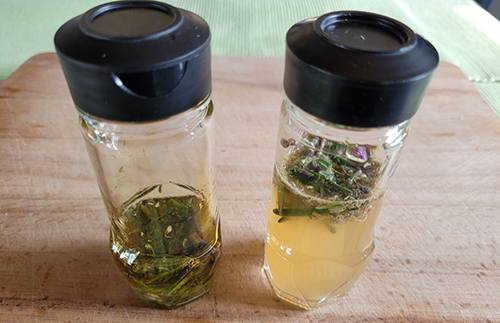
Step 6: Once the allotted time has passed, sieve and decant the oil and vinegar infusions into appropriate containers. Dispose of the remaining plant material. I use an upcycled 1-ounce essential oil bottle with a dropper for the Rosemary Hair and Scalp Massage Oil. This one ounce of oil lasts me several months which is why I make such a small batch. I use a glass spray bottle that holds 2 ounces for the Rosemary Scalp and Hair Spray. It lasts me a similar amount of time.
Potential Uses
Start by spraying the scalp by parting hair intermittently across the scalp. Allow the spray to rest in place for a minute or two.
Then massage a drop or two of oil to problem areas of the scalp.
You may choose to comb or brush through the length of hair. I use my hands and allow the oil to reach the hair ends.

Leave on hair for as long as possible. I wash my hair a couple of times a week, so this may be on my hair for a couple of days. I may even repeat the above process a couple of times between washing. It just feels quite nice. Putting it on just an hour or so before washing will still be helpful and effective.
The wonderful aromatic spray and oil have a lovely fragrance. Even so, many people may prefer to wash it out before appearing in public as it is, obviously, on the oily side. To protect headrests, pillowcases, hats, and items that touch your head, you may want to wear a scarf or turban to protect from the oily residue.
Potential Dosages of Rosemary
- Rosemary Leaf in capsules, dried form, or as tea: 1 – 2 grams per day, or 1 to 3 cups of tea per day.
- Rosemary tincture, extract, or infused oils: 2 – 4 mL orally three times daily.
- Rosemary Essential Oil used topically: Dilute in a carrier oil at 6% to 10% essential oil.
How To Preserve Rosemary
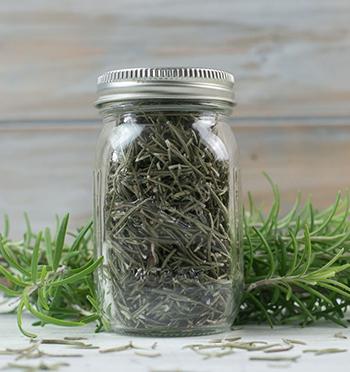 Rosemary is the best fresh, of course, but that is not always possible. Dried and frozen rosemary are two excellent ways to preserve this plant.
Rosemary is the best fresh, of course, but that is not always possible. Dried and frozen rosemary are two excellent ways to preserve this plant.
To Dry Rosemary:
Harvest the best rosemary leaves available. Long stems can be hung in an area protected from light with excellent air circulation. Once the leaves are completely dry, they can be removed from the stems and placed in air-tight containers out of direct light. Use as needed within 18 to 24 months.
Related: How To Properly Dry Plants for Medicine (video)
To Freeze Rosemary:
Harvest the best rosemary leaves available. Long stems or leaves can be placed on cookie sheets and placed in the freezer. Once frozen, usually within 14 to 24 hours, place stems or leaves into airtight freezer containers. Re-usable glass jars work great, or freezer bags are a good option as well. Frozen herbs such as rosemary hold their flavor and healthful attributes for 12 to 18 months.
Related: How to Make Herbal Ice Cubes
What Plants Resemble Plant?
| Feature | Rosemary, Salvia rosmarinus | Mountain Mint, Pycnanthemum tenuifolium | French lavender, Lavandula dentata |
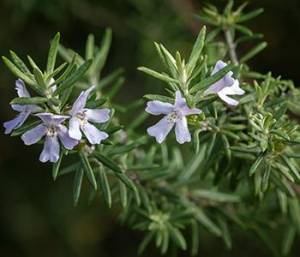 |
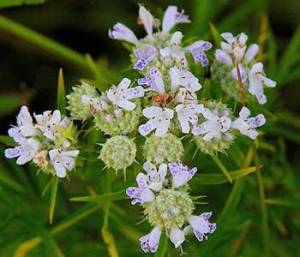 |
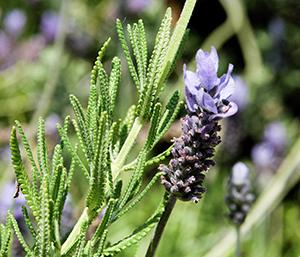 |
|
| Size | Upright, rounded, evergreen shrub grows 4 to 6 feet tall. | Herbaceous bushy perennial grows 1 to 3 feet tall. | Up to 24 inches tall, in open spreading habit. |
| Leaves and Stems | The needle-like leaves are up to 1.5 inches long, gray-green in color, with pale undersides. Smooth, square stems. | Slender stems hold 3-inch-long slender leaves. Both are hairless and leaves have smooth margins. | The lance-shaped leaves are slightly wooly and gray green in color on similarly wooly, aromatic stems |
| Flowers | Two-lipped blue to white flowers are tiny. They bloom in early spring in clusters at the axils of last year’s wood. | Small ¼ inch tubular flowers are white, sometimes with purple dots. They appear for 1 ½ months in early to mid-summer. | Purple flowers appear in late spring on long lasting tall narrow spikes. |
Warnings And Cautions
Rosemary is not known to have mild, moderate, serious, or severe drug interactions. Any food or herbal remedy should be commenced with caution and large quantities should be avoided due to potential adverse effects or allergic reactions. Extra caution should be taken for those on diabetes or blood-thinning medications and pregnant or nursing women.
Rosemary is considered safe for culinary and topical use. Of course, with any new ingredient, do a small skin test by placing a small amount of the oil or resin on the skin and wait 24 hours. Any reaction such as itchiness or hives may be an indication of sensitivity. It only makes sense to practice some caution with topical use for people who suffer from allergies.
Always check with your healthcare provider before starting new herbal remedies.
You may also like:
1 Cup Before Bed Shrinks Belly Fat All Night (Video)
10 Herbs That Kill Viruses and Clear Lungs
DIY Colon Detox with Ingredients You Have in Your Kitchen Right Now

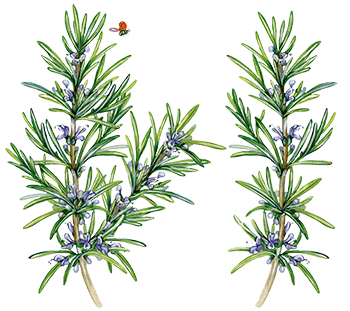

Excellent information about this herb – very concise and detailed.
Thanks – look forward to same on other herbs.
Way too long
Never found what to do at bedtime
I agree with Nancy. Can you give us a headline or link to answer the question that got us on this page?
AGREE!.. and I really find ” click bait” quite annoying!!!
I agree with Nancy. Is it about the tea?
I agree with Nancy ALSO
Yep! Good info but click bait.
Agree!
Hi,
There are many theories that suggest different ways of improving memory or thinking more clearly, theories that are presented in this article. One of those is the idea that adding rosemary to your food or water or even breathing in its scent, can give your brain a boost.
A recent study published in the International Journal of Neuroscience found that rosemary significantly enhanced the quality of memory and increased mental alertness.
Add a few drops of rosemary oil to lotion and apply it to your neck, or use a diffuser to reap the mental benefits of rosemary oil’s aroma. Whenever you need a boost of mental energy, you can even inhale over a bottle of oil to get the same effects.
“The ONLY thing you should do with it – right before going to bed (it takes just 1 sec)” is referring to simply inhaling rosemary essential oil before bed.
However, be aware that overexposure and the act of inhaling essential oils can lead to headaches.
We apologize if that was not stated very clearly in the article.
Many blessings and good health!
I was interested to find out about bedtime use to help memory. The article only mentions this on the first page. Did you forget to insert that part? 🙂 Thanks for these articles, full of useful information…
Hi Carol,
Thank you for reaching out to us.
There are many theories that suggest different ways of improving memory or thinking more clearly, theories that are presented in this article. One of those is the idea that adding rosemary to your food or water or even breathing in its scent, can give your brain a boost.
A recent study published in the International Journal of Neuroscience found that rosemary significantly enhanced the quality of memory and increased mental alertness.
Add a few drops of rosemary oil to lotion and apply it to your neck, or use a diffuser to reap the mental benefits of rosemary oil’s aroma. Whenever you need a boost of mental energy, you can even inhale over a bottle of oil to get the same effects.
“The ONLY thing you should do with it – right before going to bed (it takes just 1 sec)” is referring to simply inhaling rosemary essential oil before bed.
However, be aware that overexposure and the act of inhaling essential oils can lead to headaches.
We apologize if that was not stated very clearly in the article.
Many blessings and good health!
I agree, but then I found the memory recipe link in the green line just above the comments.
Is all rosemary edible?
Interesting but never found the answer to the question that got me here.
It’s not rocket science, people. Just use a diffuser for the essential oil at bedtime.
Indeed not rocket but rather rosemary science 🙂
Don’t be rude. Now I have to look up diffuser and essential oil, even more incomplete instructions.
The link for memory elixir was just under the recipe for rosemary tea, as well.
there is not one mention of the benefit of using it at bedtime and what it should be combined with so , although it is not “rocket science”, the article did not answer the question!!
Thank you. I want to grow so all content was appreciated.
Rosemary essential oil is so versatile. It is great for everything mentioned above and more BUT you must ALWAYS read the precautions on oils eg: Rosemary is an abortive oil and should NEVER be used on women even planning to get pregnant. Essential oils are amazing but getting the right information of use is imperative.
Thank you so much! I will save and share your article! Dee Turner
I see a mention of Rosemary extract but no recipe… Is it the normal fill to 3/4 and fill with Vodka?